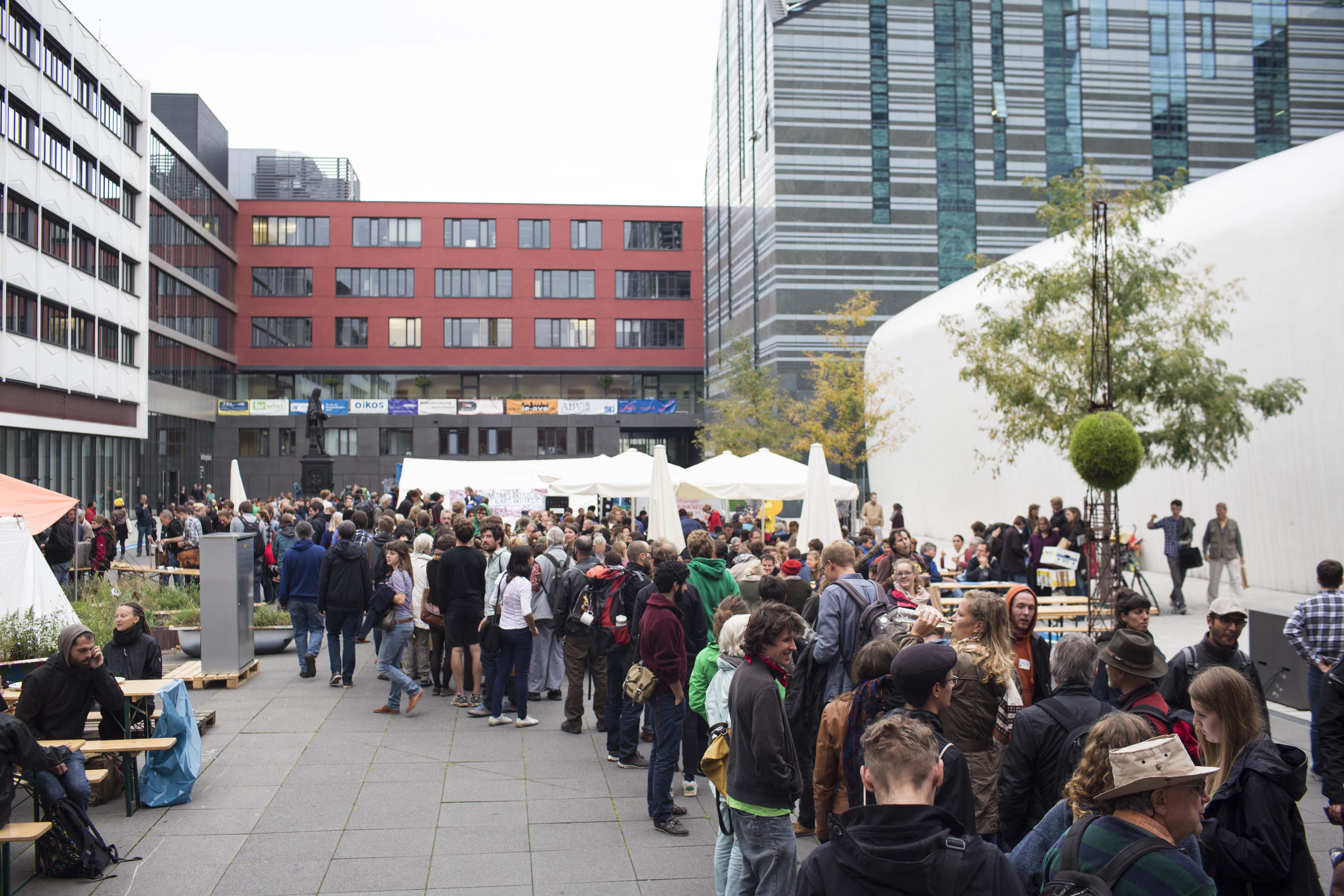By Niko Paech
The legend of green growth depends on three basic principles: (1) Increase of resource-efficiency, (2) closed material flow cycles and (3) renewable energies. However, despite a host of innovations in the field of climate protection, the ecological damages in the area of energy have been and still are on the rise. The process of ecological modernization reveals itself as a history of technological failures and relocation of the ecological damages in space, time and systems. In addition, even the social niches in which progressive ecological lifestyles began to spark at the end of the 70s and beginning of the 80s are already drowned in a flood of material build-up, digitalization, pollution through one-way packaging and – first and foremost - air traffic.
At the same time, the numbers of events, meetings, networks, initiatives or projects claiming sustainability are reaching new heights everywhere. Until now, climate protection has only taken place on the level of mere symbolism. Lifestyles compatible to climate protection are not being exercised even where the calls for it are the loudest.Increasing the Gross Domestic Product (GDP) requires additional production that, as an economic activity, has to be transferred from at least one provider to a demander, thereby inducing cash-flow. Consequently, this added value splits up into a material origin side and a financial use side of the additional income. Both impacts would have to be neutralized in order to keep the economy growing without causing additional ecological damages. This means, even if the generation of a monetarily measurable and hence GDP-relevant performance transfer could ever be technically dematerialized – which is not foreseeable as of now, apart from a few laboratory-experiments – the problem of decoupling would remain unsolved as long as it is possible to use the additional income for purchasing any goods that are not completely dematerialized. The following paragraphs will shed light on both sides:
What would goods look like that can be transferred as a service worth money from at least one provider to a demander, and that are at the same time free from any consumption of land, material or energy in production, physical transfer, use and disposal? All green-growth solutions proposed up until now most evidently do not fulfil these requirements: Regardless of whether they are passive houses, electronic vehicles, eco-textiles, photovoltaic systems, organic food products, offshore wind power stations, heat and power cogeneration units, solar-thermal heaters, cradle-to-cradle drink packages, car-sharing, digital services etc. Nothing of all this can exist without physical input and new production capacities and infrastructures in particular.
But couldn’t green efficiency or consistency solutions simply replace any type of less sustainable output instead of causing a material addition? In order to achieve a substitution that truly reduces ecological impact, it is not enough to simply replace output-flows, as long as this goes along with increases in material stock sizes and land use (as is the case with passive houses and renewable energy-facilities). In addition, the previous capacities and infrastructures would have to be dismantled. However, how could the materials of whole industries and building complexes disappear in an ecologically neutral manner?
On top of this comes a second dilemma: how could the GDP permanently grow if each profit from the green value added were countered by a loss of non-sustainable value added due to the deconstruction of old structures? This can be traced with the example of the German “Energiewende”: To begin with, the contribution of renewable energies to the economic value added, which the green growth community is currently praising, at a closer look turns out to be a flash in the pan at its best. Whenever the installation of additive capacities is finished, the contribution to the added value is reduced to an energy flow that, in comparison, does not require a great deal of value-adding input and cannot be increased arbitrarily – unless the production of new facilities is continued without limitations. In this case, there would be further environmental damages: Landscape destructions, already unbearable, would increase due to the expansion of material stock sizes. Here the problem of material relocation-effects becomes obvious: In most cases “green” technologies do not solve ecological problems – they only transfer them to other physical, spatial, temporal and systemic dimensions. For this reason, the attempts to empirically prove the success of decoupling are only as useful as it is possible to consider all relocation-effects. But how should, for example, CO2 savings be balanced with landscape destructions?
Even if dematerialized production increases were possible some day, the unavoidable corresponding income increases would have to be ecologically neutralized too. Yet it has proven simply unthinkable to keep the basket of goods of those consumers who obtain the additional income generated in the green sectors, free from resource-intensive, globally produced items. Would these people not buy homes, travel by plane, drive cars or pursue conventional consumption activities – which tend to increase in line with the growth in available incomes?
Another financial rebound-effect lurks wherever green investments raise the overall output, owed to the fact that old capacities are not simultaneously deconstructed to the same extent (additional passive houses increase the net dwelling area and new photovoltaic systems increase the net energy output) – a situation that tends to cause price-reductions leading to increases in demand. It can't even be ruled out that the fossil sector benefits from this too.
A third financial rebound-effect occurs wherever efficiency gains reduce the operating costs of certain objects (houses, cars, lights, etc.).
Theoretically, it would be possible to avoid these rebound-effects if all generated income increases were absorbed – but why would we then need growth altogether? What could be more absurd than generating growth, just to neutralize the intended effect, namely the increase of income, at the same moment? Accordingly, the assertion that through investment in green technologies, growth could go along with an absolute decrease in environmental burdens is not only flawed, but even converted into the exact opposite: from the perspective of financial rebound-effects, green technologies can only have a chance to relieve the ecosphere under conditions of a non-growing GDP. And this is not even a secure condition, given that the material effects on the generation side – especially the uncountable relocation options – also have to be accounted for.
On top of this, the strategy of decoupling brings an ethical problem too: The fate of humanity would be at the mercy of a technological progress that has not become reality so far and whose future realization is impossible to prove – notwithstanding that it might cause more additional problems than it is able to resolve. Can such roulette that is not born out of necessity but pursued solely for the sake of increasing an already exuberant prosperity, really be responsible?
A green growth that depends on decoupling modern consumption and mobility practices from ecological damages fails already due to the deeply-rooted misconception that individual objects or activities themselves can be linked with attributes of sustainability. Why should a three-litre car for example be more climate-friendly than a 25 litre guzzling Opel Admiral if the owner of the first one commutes 200 kilometres every day whereas the Admiral-owner uses his vehicle only five times per year and cycles otherwise? To which extent does a passive house contribute to sustainable development if its inhabitants possess as many flat screens, computers, coffee-machines and hi-fi equipment as they have rooms? What is the point if those who grow carrots in community gardens spend their vacation in the Caribbean and fly for the next network meeting to Latin America? How many human lifetimes would be required to compensate the CO2 emissions of a single intercontinental flight through constant consumption of organic lemonade, waste separation and a car-sharing membership?
Only individual CO2 balances are a reliable target value. The central question here is: Which amount of material freedom can a single individual be allowed to appropriate without living beyond his or her means? In relation to a 2 degrees C temperature target, this means that every individual can have an annual budget of 2,7 tons of CO2 emissions. In comparison, the current average rate of individually caused emissions in Germany for example mounts up to about 11 tons.
Seemingly sustainable single activities and products increasingly unfold mere symbolism utilized to morally compensate for something else, unsustainable and pursued by the same individual: “Recently I've only bought organic T-shirts and participated in every climate-meeting, so I don't also have to give up my vacation in India, do I?”
Alongside the expansion of “green products” and isolated sustainability simulations that have no effect anyway because they are additive, there is also an increase in the amount of untouched sustainability deficits that these happen to compensate and justify. So also from this perspective, the only remaining way out is the reduction of CO2-intensive-self-fulfilment-ideas, i.e. the transition to a post-growth economy. A CO2 budget of 2,7 tons does not allow large leaps but points to the fact that climate protection requires settled ways of life, kerosene-free happiness.
Translation: Christiane Kliemann > Comment on this article on the German blog "Postwachstum" ----------------
In a recent op-ed published in Le Monde, French economist – and Emmanuel Macron’s economic program inspirer – Jean Pisani-Ferry argued that economic growth was necessary to fight against climate change and called for eco-productivism. The following op-ed is a reply to Pr. Pisani-Ferry that was originally published in Le Monde (in French). Recently, there have been calls for eco-productivis...

By Christiane Kliemann When talking about building alliances - the focus of the third conference day - the issue of equality immediately comes into view, as there are many dimensions of inequality deeply rooted in the current growth-based economic model. In order to overcome this model, all these dimensions need to be addressed and all possible change-agents equally taken on board. Adelhei...

Europe is exhausted. It is exhausted after long years of what is labeled as the Eurozone crisis. It is exhausted after years of economic success and – now – prolonged years of political failure. Every single attempt of deepening the political union of Europe after the enactment of the Maastricht Treaty in 1993 and the [...]